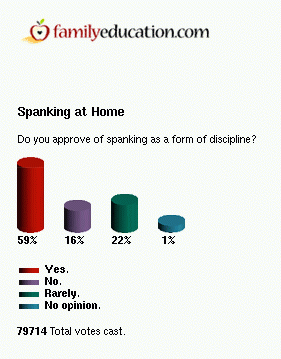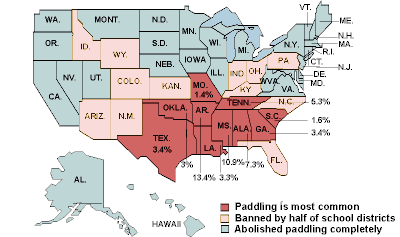Statistics
Worldwide, eight states do not allow parental spanking (all of them in Europe): Norway, Sweden, Denmark, Austria, Finland, Italy, Latvia and Cyprus. (Reference)
Since studies about spanking at schools are closely related, some of
them are also quoted below. It can probably be assumed that countries/states
with high rates of school spanking will also have high rates of parental
spanking.

Parental spanking in the U.S.A.
- U.S. law: United States statutes pertaining to spanking, by state.
- The Family Research Laboratory of the University of New Hampshire conducted a large study involving over 3,000 mothers of 3 to 5 year old children during the late 1980's. The women were interviewed in 1986, 1988 and 1990. They found that 63% of the mothers had spanked their child at least once during the previous week. Among those that spanked, they hit their children a little over 3 times per week, on average.
- The Family Research Laboratory of the University of New Hampshire examined 960 American children who were between one and four years old between 1986 and 1990. 13% of the parents studied reported spanking their children 7 or more times a week; the average was 3.6 times. 27% reported using no physical punishment.
- In 1997, 65 percent of Americans approved of spanking, not much less than the 74 percent who did so in 1946.
- The chart below shows the October 2000 results of a web poll conducted by www.familyeducation.com. This paricular poll about "spanking at home" can be found here. As about 80,000 people already participated, the figures should be pretty stable. However, "take these results with a grain of salt. Unlike the scientifically designed and implemented polls that you see on the evening news, open Web polls such as this one are notoriously unscientific." For example, participation in this poll is not restricted to U.S. parents, so the figures show a sort of "weighed worldwide average".
- Implements: In response to a 1995 poll, almost 20 percent of parents said they had hit a child on the bottom with a brush, belt, or stick in the past year; another 10 percent said they had spanked the child with a "hard object."
- Two thirds of U. S. mothers of children under 6 spank them at least three times a week.
- Research up to about 1980 shows that more than 90% of parents used corporal punishment on toddlers, and just over half continued this into the early teen years. (...) The 1986 General Social Survey found that 84% percent agreed that "It is sometimes necessary to discipline a child with a good hard spanking" (Lehman, 1989). A survey of pediatricians found that 77% supported use of corporal punishment (White, 1993).
- A 1992 study in Ohio showed that 70% of 800 family physicians and 59% of 400 pediatricians supported spanking. In 1968, 94% of Americans, and perhaps also of Canadians, believed that spanking was sometimes necessary. (...) US national surveys of parents in 1975, 1985 and 1995 found little change in the proportion who reported hitting their toddlers (from 97% in 1975 to 94% in 1995).
- A 1994 survey at the Albert Einstein College of Medicine in New York found that 74% of parents believe it is appropriate to spank children between the ages of 1 and 3, while 19% approve of spanking children under the age of 1. A 1995 Harris Poll found that 80% of parents surveyed had spanked their children, while 87% said spanking is sometimes appropriate. These numbers are declining. In 1968, 94% of the adult population believed it was sometimes necessary to spank.
(Reference)
(Reference)
(Reference link broken)

(Reference)
(Reference)
(Reference)
(Reference)
(Reference)
(Reference link broken)
School spanking in the U.S.A.
- At present, the following 23 U.S. states permit paddling at schools: Alabama, Arizona, Arkansas, Colorado, Delaware, Florida, Georgia, Idaho, Indiana, Kansas, Kentucky, Louisiana, Missouri, Mississippi, New Mexico, North Carolina, Ohio, Oklahoma, Pennsylvania, South Carolina, Tennessee, Texas, Wyoming. According to estimates from the federal Department of Education, there were about 458,000 paddlings of students in the 1996/97 school year. Total paddlings were equivalent to 1% of the total US school population. This might be an underestimate, since anecdotal evidence suggests that some, maybe many, punishments are not properly recorded. In percentage terms the heaviest-paddling states in 1996/97 were Mississippi (12.4 per cent of students paddled during the year) followed by Arkansas (less than 11%). Alabama comes third with over 6%.
- Private schools in several states (including Alaska, California, Illinois, Michigan, Nevada, New York, Utah and Washington State) are not affected by state bans.
- 32 states have abolished corporal punishment in day care centers.
- See here for detailed listings of present U.S. school corporal punishment laws, by state:

(Reference)
(Reference)
(Reference link broken)
(Reference) (new link)
Canada
- In 1999, the Canadian Medical Association Journal conducted a general population survey of 9953 residents of Ontario aged 15 years and older. The majority of respondents indicated that they had been slapped or spanked, or both, by an adult during childhood "sometimes" (33.4%) or "rarely" (40.9%); 5.5% reported that this occurred "often." The remainder (20.2%) reported "never" experiencing these behaviours. Significantly more female than male respondents reported "never" being slapped or spanked by an adult while growing up (23.9% v. 16.4%). This table (new link) shows the exact figures. For a discussion of this study, see the links after "Heat and light in the childhood spanking debate" at the top of the page.
(Reference) (new link)
United Kingdom
- 63% of mothers surveyed in 1985 said they start spanking babies before they are a year old. In Britain, almost all four year olds are spanked (97% of a big random sample of British children). Three quarters of that British sample were still spanked regularly 1 - 6 times a week and one in eight were spanked at least once a day.
- UK law currently allows parents to use ‘reasonable chastisement’ in disciplining their children. The largest and most recent government-sponsored research into punishment in families took place in 1995, supported by the Department of Health. It involved interviews with over 400 families and found 91% of children had been hit, 77% in the last year. 38% of children aged 4, and 27% of children aged 7 were hit more often than once a week, compared with 3% of 11-year-olds.
- School corporal punishment was banned from Britain's private schools in September 1999. Caning was banned from state-run schools in 1986.
-
Scotland: A public opinion survey
was carried out for us by System Three Scotland in September 1991. 83%
of the respondents considered that it should be lawful for a parent to
smack a 3 year old child with the open hand in a way not likely to cause
lasting injury. Only 3% thought that it should be lawful for a parent to
hit a 3 year old child with a belt, stick or other object. In relation
to a 9 year old, 87% thought that it should be lawful to smack, and 7%
thought that it should be lawful to hit a 9 year old with a belt, stick
or other object. In relation to a 15 year old, 68% thought that it should
be lawful to smack, and 10% thought that it should be lawful for a parent
to hit a 15 year old with a belt, stick or other object.
(Reference)
(Reference link broken)
(Reference link broken)
(Reference link broken)
France
- new (Jan): More than half the French (54.5%) say to spank their children often, according to a survey carried out by Sofres in January 1999. (Reference)
Germany
- Thirty percent of German parents are said to use spanking as a punishment.
-
Corporal punishment at german schools was banned in the 1970's.
(Reference link broken) - On July 10, 2000 the german parliament passed a measure prohibiting the use of corporal punishment in child rearing. The bill is slated to go into effect on January 1 of the coming year (2001). The new law "does not seek to criminalize parents. It is meant to change parental consciousness regarding the disciplining of children."
(Reference)
(Reference link broken)
Kenya
- Kenyan law allows the use of corporal punishment at schools. In Kenya, the most common method of corporal punishment involves teachers striking students with a cane. The headteacher may give no more than six strokes, according to Kenyan law.
- In practice, children are generally forced to kneel down (occasionally to lie down) in the front of the classroom before being caned or beaten in front of other students. At other times, teachers simply cane children on the spot, as they sit in their chairs. For the most part, boys are hit on the backside, while girls are hit on the palm of the hand. Depending on the nature of the misbehavior of the child and the harshness of the teacher and school, a student might receive anywhere from two to twenty or more cane strokes at one time.
- The full 1999 HRW report "Spare the Child" about corporal punishment in Kenyan schools can be found here.
(Reference)
(Reference)
(Reference)
Liberia
- new (Nov): BBC News article: "...Liberia's President Charles Taylor has administered publicly 10 lashes to one of his daughters after the school suspended her for indiscipline...Many African countries allow corporal punishment, though in Liberia the practice has become unfashionable since the end of the brutal seven-year civil war. Corporal punishment used to be a tradition in Liberian schools but the emergence of child rights advocacy groups as a result of the country's civil war, has made the practice unfashionable. Indiscipline has become a major problem in Liberian schools."
(Reference)
South Africa
- The South African Schools Act 84 of 1996 prohibits corporal punishment in schools. However, certain independent Christian schools, under the banner of Christian Education South Africa (CESA), have allowed corporal punishment to be administered to pupils.
- There is a court ruling against this practice which can be read here in full.
- new (Nov): "Dungeons and sjamboks in school's reign of terror": an article about abusive corporal punishment in a South African exclusive high school. Note: a 'sjambok' is a whip made of animal hide. Warning: this article shows a photograph of a severely whipped student's buttocks.
(Reference link broken)
(Reference link broken)
(Reference)
Japan
- The Educational Research Center, Benesse Corporation, conducted a retrospective survey of approximately 600 mothers of 13-year-old children. Although corporal punishment at school is legally prohibited in Japan, the survey revealed that 56% of the children received corporal punishment during primary school (ages 6 to 12 years). Among the children, 50% accepted the corporal punishment. Of the parents, 80% did not protest the teacher's use of corporal punishment.
-
new (Oct):
More from the same study:
The survey revealed that 44% of the children had received no corporal
punishment during primary school (ages 6 to 12 years), but 56% of them had
been punished in this manner once or more since that time.
The mothers' feelings were as follows: 50% were able to accept or tolerate
the corporal punishment because their child had misbehaved, 16% of the
mothers denied their child had misbehaved, but only 20% protested the
teacher's use of corporal punishment.
In general, parents considered "mild corporal punishment" acceptable, but
they did not approve of "striking," "punching," "beating," or "kicking."
Milder corporal punishment means "spanking on the bottom" and also, "kneeling,"
or being "forced to stay after school and study," which are acceptable to
parents. However, parents believe that corporal punishment is always
permissible in cases such as "delinquent behavior," "dangerous activities,"
or "bullying."
(Reference)
(Reference link broken)
Thailand
- Caning at schools is widespread in Thailand, but the Education Ministry has banned corporal punishment at schools, effective Nov 1, 2000. Reportedly, most teachers in Thailand feel that they will lose control of their classrooms without the cane.
(Reference link broken)
Sri Lanka
- Here is an article about parental and school spanking in Sri Lanka.
(Reference link broken)
Samoa
- "... law and tradition prohibit severe abuse of children, but tradition tolerates corporal punishment."
(Reference)
Australia
- An Australian study found that 94 per cent of children aged between four and 14 had been smacked, 36 per cent with an implement.
(Reference link broken)
If you know of any further related statistical material (especially from non-U.S. countries), please send it to [email protected]
Last update: Jul-21-2003
